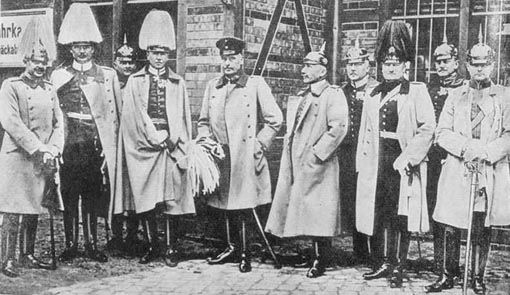 |
|
|
|
|
 |
|
Constantinople was under allied occupation and control whereas Kemal’s nationalist movement had free reign in Asia Minor with exception in the Vilayet of Smyrna being under Greek jurisdiction. Second the Kemalists wanted to implement the Turkish National Pact (Kuvayi Milliye)as part of their political and military strategy to remove all vestiges of foreign occupation from Turkish soil. It is interesting to note that the last Ottoman Sultan Muhammad VI (or Mehmet VI or Vahdettin) regarded Kemal as a rebel. The main issue for resolution was reconciliation between them. However in November 1922 the Sultan secretly left Constantinople on board a British warship never returning to Turkey .His cousin Abdülmecit succeeded him in his role as caliph up to 1924. Finally under the provisions of the armistice of Mudros, the allies-Britain, France and Italy had the right to occupy strategic points in the Ottoman Empire. The Treaty of Sevres which was imposed on the Ottoman Empire by the Allies was not ratified by the nationalist government in Angora. However, the Greek Government considered the provisions of this treaty as legally binding and enforceable on the Turks. Kemal, however, had other ideas. In February/March and June 1921 and March 1922, the Allied powers mediation to end the Greco-Turkish war ended in abject failure. The armistice of Mudros remained in force, until a new one was arranged in Moudania in October 1922.13 There are another two aspects of the article above that require an explanation. It is stated “that the Turkish flag has been hoisted by all Islam from Stamboul to Calcutta to honor Turkish advances.”14 US diplomats posted in Nairobi, Damascus, Beirut and Cairo sent dispatches to the State Department enclosing local news reports showing the elation of Moslems in Kemal’s victory over the Greeks. For e.g. the East African Standard newspaper published in Nairobi, Kenya, Elif- Bah in Damascus, Rayel- Aam in Beirut and the Egyptian Gazette in Alexandria.15 13The following published documentary and secondary sources were consulted for points 1-3. These are Documents on British Foreign Policy, 1919-1939, first series, Vols. IV, VII, VIII, 1X, XII, XIII, XV, XVII, and XVIII. H.M.S.O; Kenneth Bourne & D. Cameron Watt [General Editors], British Documents on Foreign Affairs: Reports and Papers from the Foreign Office Confidential Print, Series F Europe, 1919-39, vols 4&5 Italy and South-Eastern Europe, November 1918-June 1921 & July 1921-December 1923, University Publications of America; Bilal.N.Simsir (Ed) British Documents on Ataturk 4 Vols, Turkish Historical Society, Ankara, 1984-92; B.C. Busch, Mudros to Lausanne:1918-1923, State University of New York Press, Albany, 1976; Michael Llewellyn. Smith, Ionian Vision, Allen Lane, London, 1973; A. Alexandris, The Greek Minority of Istanbul and Greek-Turkish relations 1918-1974, Center for Asia Minor Studies, Athens, 1983;S. R. Sonyel, Ataturk-The Founder of Modern Turkey, Turkish Historical Society, Ankara, 1989. 14Los Angeles Times, “SAYS TURKS CAN REGAIN STRAITS. German General Elated at War News Commanded Mohammedans in World Conflict Kemal Pasha His Pupil in Military Affairs”, September 17, 1922 part.1 15National Archives and Records Administration, Records of the Department of State relating to the Political relations between Turkey and other States M363, Record Group 59, 767.68/501 American Consulate, Nairobi, Colony of Kenya, Africa to Secretary of State, Washington with enclosure; 767.68/492 American Consulate Damascus , Syria to Sec of State, Washington, October 6, 1922 with enclosure; |
|
About the Author Stavros Terry Stavridis was born in Cairo, Egypt in 1949 of Greek parents. He migrated to Australia with his parents in September 1952. Stavros has a Bachelor of Arts (B.A) in Political Science/Economic History and B.A (Hons) in European History from Deakin University and M.A in Greek/Australian History from RMIT University. His MA thesis is titled "The Greek-Turkish War 1919-23: an Australian Press Perspective." Stavros has nearly 20 years of teaching experience, lecturing at University and TAFE (Technical and Further Education, the equivalent of Community College in the US) levels. He has presented papers at international conferences in Australia and USA and has also given public lectures both in Australia and on the West Coast of the US. Many of his articles have appeared in the Greek-American press. He currently works as a historical researcher at the National Center for Hellenic Studies and Research, Latrobe University, Bundoora, Victoria, Australia. Stavros' research interests are the Asia Minor campaign and disaster, Middle Eastern history, the Assyrian and Armenian genocides, Greece in the Balkan Wars 1912-13 and the First World War and history in general. HCS maintains a large selection of fine pieces written by Mr. Stavridis which viewers are invited to view at the URL http://www.helleniccomserve.com/stavridisone.html Read More About the Greeks of Asia Minor HCS readers who enjoyed this article may wish to view others about Smyrna and Asia Minor in our section specially created for these topics at the URL http://www.helleniccomserve.com/smyrnaopener.html. We also maintain a permanent, extensive archives of articles which readers are invited to browse at the URL http://www.helleniccomserve.com/archivesmyrnaasiaminor.html . |
|
|
|
|
2000 © Hellenic Communication Service, L.L.C. All Rights Reserved. http://www.HellenicComServe.com |
|
